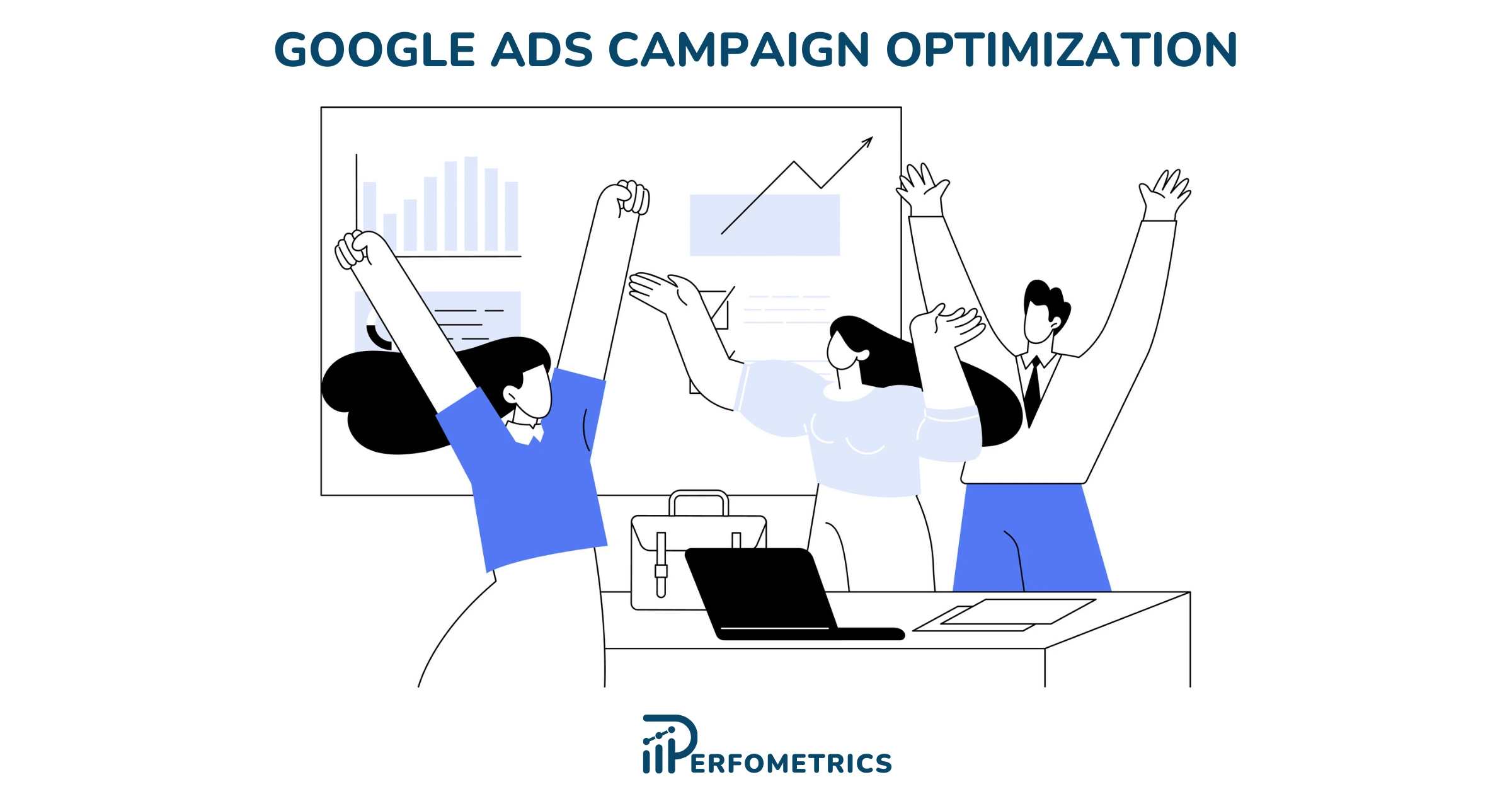Complete Guide to Google Ads Campaign Optimization

Are you ready to unlock the full potential of your Google Ads campaigns through Google Ads campaign optimization? Imagine boosting your return on investment (ROI) by making simple yet strategic adjustments to your campaigns.
Understand Google Ads Campaign Optimization
Google Ads campaigns are a powerful way to reach potential customers through keyword-driven digital advertisements that appear on search engine results pages (SERPs) or through audiences and other targeting methods.
To optimize Google Ads, regular optimization is needed to maximize the effectiveness of your campaigns, including the use of dynamic search ads and responsive search ads. This might seem challenging due to the constant changes in Google’s interface, metrics, and automation.
However, with a solid understanding of Google Ads optimization and a step-by-step Google Ads optimization checklist, you can ensure your campaigns are running efficiently and achieving your business objectives.
What is Google Ads optimization?
Google Ads optimization is the process of examining your Google Ads data and making incremental changes to ensure optimal performance. This includes picking the right keywords, adjusting bidding, and using an optimization score, which ranges from 0-100%, to prioritize recommendations across campaign types.
How to Optimize Google Ads Campaigns?
To optimize your Google Ads campaign, use negative keywords to exclude irrelevant searches, focus on 1-2 selling points for stronger impact, use a landing page that drives sales, and leverage assets such as Google Analytics and in-market segments. Additionally, you can take advantage of specialized platforms, target specific audiences using RLSAs, and get rid of vanity metrics.
Optimizing Google Ads campaigns involves various aspects, such as:
- Organizing ad groups
- Aligning keywords with ad copy
- Monitoring and analyzing campaign performance
- Implementing effective keyword strategies
Addressing each of these elements will enhance ad relevance, minimize unnecessary ad expenditure, and improve your campaign performance and ROI.
1. Set Up Your Google Ads Account for Success
A well-structured Google Ads account is the foundation for a successful campaign, as poorly structured accounts can result in lower Quality Scores, irrelevant clicks, and increased costs.
This section covers two key components of setting up a successful Google Ads account: organizing ad groups and aligning keywords with ad copy.
Organize Ad Groups
Ad groups in a Google Ads account serve to organize and categorize ads according to their semantic relevance. A well-thought-out ad group structure improves ad targeting and ad relevance, ultimately boosting click-through rates and overall campaign performance. To achieve this, follow best practices for structuring ad groups in Google Ads. This includes:
- Using consistent naming conventions
- Creating 5-15 ad groups per campaign
- Clustering keywords by themes
- Limiting the number of keywords per ad group
Categorizing ad groups in a Google Ads campaign can yield several advantages, such as:
- Improved alignment of keywords, ad messages, and landing pages with your business’s objectives
- Better organization and targeting, resulting in enhanced campaign performance and higher return on investment
- Boosting Quality Score
- Raising click-through rates
- Reducing costs
This structure allows for better organization and targeting, resulting in enhanced campaign performance and higher return on investment. Moreover, it can help to boost Quality Score, raise click-through rates, and reduce costs.
Align Keywords with Ad Copy
Aligning keywords with ad copy is vital for enhancing Google Ads Quality Score and improving ad relevance. Ensuring that the ad copy accurately reflects the intent and relevance of the keywords signals to Google that your ad is highly relevant to the user’s search query. This alignment raises the probability of the ad being clicked, which in turn increases the ad’s click-through rate (CTR). Consequently, aligning keywords with ad copy positively affects Google Ads Quality Score.
When coordinating keywords with ad copy, it is important to be aware of some common errors, such as:
- Inadequate keyword research
- Incorrect grouping of keywords
- Grammatical and spelling errors in ad copy
- Keyword stuffing
- Omitting ad extensions
- Using a generic landing page copy
Avoiding these mistakes ensures that your ad copy aligns with your keywords, which can lead to improved ad performance, higher optimization score in Google Ads and Quality Score.
2. Monitor and Analyze Campaign Performance
Monitoring and analyzing campaign performance is essential to assess the success of your campaigns and identify areas for improvement.
Implement Conversion Tracking
Conversion tracking in Google Ads allows you to track and evaluate the outcomes of customer interactions with your ads. Implementing conversion tracking allows for the optimization of Google Ads campaigns and the maximization of return on investment (ROI). To accurately monitor conversions, ensure that you have implemented conversion tracking in your Google Ads account.
Conversion tracking provides essential data for measuring the effectiveness of your campaigns and identifying areas for improvement. By tracking the number of conversions received across your conversion actions, you can evaluate the performance of your campaigns, keywords, ads, and audiences. Additionally, tracking app installs and other valuable activities can help you further assess the success of your campaigns and calculate your ROI and cost per click (CPC) over time.
Integrate Google Analytics with Google Ads
Integrating Google Analytics with your Google Ads account offers invaluable insights into user activity and campaign effectiveness. By linking Google Analytics and Google Ads, you can gain a deeper understanding of:
- The effectiveness of your ads in driving website traffic, conversions, and engagement
- Analyzing specific URLs on your website
- Tracking user behavior
- Measuring the impact of your ads on various metrics such as bounce rate, time on site, and goal completions
This integration helps advertisers make informed decisions, optimize their campaigns, and improve their return on investment (ROI).
However, it is essential to note that there may be discrepancies in data between Google Analytics and Google Ads. Understanding these discrepancies and using both tools together provides a more comprehensive view of campaign performance and aids in making optimization decisions based on Google Ads data.
3. Effective Keyword Strategies for Google Ads Campaigns
Effective keyword strategy is an integral part of optimizing Google Ads campaigns. This section covers three key keyword optimizations for Google Ads campaigns: long-tail keywords, negative keywords, and keyword match types.
Target Long-Tail Keywords
Long-tail keywords are longer, more specific phrases with lower search volume but higher conversion rates. These keywords are typically used by searchers who are looking for specific topics or products.
Utilizing long-tail keywords in Google Ads provides several advantages, focusing on highly specific search queries with lower search volumes but more refined intent. This approach allows for more precise targeting, resulting in higher click-through rates (CTR), improved quality scores, and reduced costs per click.
To identify effective long-tail keywords for your Google Ads campaign, you can employ various strategies, such as:
- Searching for terms related to your business on Google.com
- Using a Keyword Planner tool
- Leveraging tools like HubSpot Content Strategy Tool, Answer the Public, Semrush, and other SEO tools
- Prioritizing long-tail keywords through campaign bidding
Identifying and targeting relevant long-tail keywords enhances the efficacy of your ads and drives higher-quality leads.
Add Negative Keywords
Negative keywords play a crucial role in optimizing Google Ads campaigns by eliminating irrelevant search queries and enhancing ad relevance.
Specifying negative keywords prevents your ads from displaying irrelevant search queries and allows you to focus on targeting the most relevant keywords for your customers. The use of negative keywords can improve the targeting and effectiveness of your Google Ads campaigns, as well as reduce wasted ad spend.
To add negative keywords to your Google Ads campaign, you can either add individual negative keywords to ad groups or campaigns or edit negative keyword lists for a specific campaign.
By incorporating negative keywords, you can ensure that your ads are only displayed for relevant search queries, resulting in improved ad performance and Quality Score.
Test Different Keyword Match Types
Keyword match types determine how closely a search query must match a keyword for an ad to show, affecting ad targeting and performance.
Google Ads offers three main keyword match types: Broad Match, Phrase Match, and Exact Match. Understanding and strategically using broad match keywords and other match types allows you to target the most relevant search queries and maximize the performance of your Google Ads campaigns.
To strategically use keyword match types in your search network, we recommend the following steps:
- Depending on your available budgets, risk tolerance, and deadlines, start with a combination of exact and phrase match types or broad matches to gather data.
- Analyze the search terms report to identify relevant keywords and search queries.
- Implement negative keywords to exclude irrelevant traffic.
- Regularly review and refine your match types based on performance data. By following these strategies, you can effectively optimize your Google Ads campaigns to achieve maximum ROI during seasonal fluctuations.
4. Optimize Ad Creatives and Landing Pages
Optimizing ad creatives and landing pages is essential for maximizing the performance of your Google Ads campaigns. This section covers three key aspects of ad creative and landing page optimization: writing compelling ad copy, A/B testing ads, and landing page optimization.
Write Compelling Ad Copy
Compelling ad copy is persuasive and engaging, prompting users to take action. Crafting compelling ad copy with clear call-to-actions (CTAs) and benefits can significantly improve ad performance and click-through rates. To create effective ad copy, consider the following tips:
- Make your CTA visible.
- Provide a clear benefit.
- Add urgency.
- Use specific and relatable language.
- Keep it simple.
A strong and convincing CTA can significantly improve the performance of your Google Ads campaigns. Focusing on crafting compelling ad copy and clear CTAs boosts the impact of your ads and drives better results for your campaigns.
A/B Test Ads
A/B testing ads involves comparing two variations of an ad to evaluate which one yields better results. Displaying the two ads to a specified target audience and assessing their performance based on metrics such as click-through rate, conversion rate, and cost per conversion helps identify the most effective ad variation and aids in making optimization decisions for your campaigns.
To set up and conduct A/B testing in Google Ads, follow these steps:
- Access your Google Ads account and select the campaign you wish to run the A/B test on.
- Select the ‘Experiments’ option.
- Set up a custom experiment by following the prompts.
- Analyze the results.
Regularly conducting A/B testing for your ads can help you identify areas of success and areas that need improvement, ensuring your ads are optimized for maximum performance and ROI. This process is essential for effectively managing your ad budget.
Optimize Landing Pages
Landing page optimization ensures a seamless user experience, improving conversion rates and overall campaign performance. A well-optimized landing page can mean the difference between a user converting or bouncing off your website. Mobile optimization is also closely intertwined with landing page optimization, as mobile device usage continues to grow. Ensuring that your landing pages are optimized for mobile users, as well as desktop users, is essential for providing a smooth user experience and maximizing conversions.
To optimize, follow our Google Ads landing page best practices and focus on factors such as page load speed, mobile-friendly design, and simple navigation. By optimizing your landing pages for both desktop and mobile users, you can enhance the overall performance of your Google Ads campaigns and increase the likelihood of conversions from both user segments.
5. Leverage Advanced Targeting and Bidding Strategies
Advanced targeting and bidding strategies can provide additional opportunities for optimizing your Google Ads campaigns. This section explores three key strategies: audience targeting, bid adjustments, and smart bidding.
Target the Right Audiences
Audience targeting in Google Ads enables you to display your ads to users who have previously visited your website or who possess similar interests or characteristics.
By targeting specific audiences, you can optimize your campaigns and maximize your return on investment. Google Ads offers a variety of audience targeting options, including:
- Affinity audiences
- Custom audiences
- Customer match
- Detailed demographics
- Life events
- In-market audiences
- Remarketing audiences
- Similar audiences
Utilizing audience targeting lets you reach a more relevant audience and tailor your ads to resonate with that specific group of users. This can help boost your ad’s pertinence to the user’s search query, resulting in higher click-through rates and improved overall campaign performance.
Apply Bid Adjustments
Bid adjustments in Google Ads enable you to modify your bids for various factors such as device type, location, and time of day based on performance and data.
Adjusting your bids based on these factors can help you allocate your budget more efficiently and target the most relevant audience, ultimately improving your ROI.
To set up and use bid adjustments in Google Ads, simply navigate to the campaign dashboard, select the desired campaign, and access the ‘Settings’ tab. From there, you can choose the appropriate bidding strategy and make adjustments based on your campaign objectives and target audience.
Implementing bid adjustments gives you greater control over your ad spend and helps optimize your Google Ads campaigns for better results. Regularly assessing and adjusting your bids can help you stay competitive and maximize your return on investment.
Use Smart Bidding Strategy
Smart Bidding strategies such as target CPA and target ROAS utilize machine learning (ML) to maximize bids for conversions or conversion value in each auction.
By leveraging Google’s AI and machine learning algorithms, Smart Bidding aims to establish bids that are more likely to achieve the desired campaign objectives. Smart Bidding is available for almost all of the campaign types, Search campaigns, Google Ads Performance Max campaign, Demand Gen campaign in Google Ads, and Video campaigns.
Machine learning plays a pivotal role in the success of the Smart Bidding strategy, as it leverages Google’s AI and machine learning algorithms to optimize ad campaigns. By utilizing machine learning to assess historical data, user behavior, and other factors, Smart Bidding makes real-time bidding decisions that are more likely to result in conversions or enhance conversion value. This eliminates the need for manual bid adjustments and facilitates more efficient and effective bidding strategies.
💡 For more, read: about Google Ads auction insights report.
6. Continuous Improvement and Iterative Testing
To ensure the ongoing success of your Google Ads campaigns, it is crucial to maintain a mindset of continuous improvement and iterative testing. This section discusses three key aspects of this approach: regular account audits, ad schedule optimization, and seasonal adjustments.
Do Regular Account Audits
Conducting regular account audits is vital for maintaining the performance of your Google Ads campaigns and identifying areas for improvement. It is suggested to conduct a comprehensive audit of Google Ads accounts regularly, depending on the complexity and scope of campaigns. A good rule of thumb is to conduct an audit every couple of weeks or once a month.
A Google Ads account audit can be beneficial for campaign performance by recognizing areas for improvement and potential opportunities. By analyzing:
- campaign settings
- costs
- ad groups
- ad performance
The audit process can identify areas of success and areas that should be optimized. Conducting audits regularly is necessary for maintaining campaign performance and identifying areas for improvement.
Optimize Ad Schedules
Ad schedule optimization involves adjusting ad delivery to capitalize on the most effective times of the day. By analyzing your campaign data and identifying the best-performing times, you can enhance ad performance and return on investment. To set up ad schedules in Google Ads, you can follow the steps outlined in the previous section.
Optimizing your ad schedules ensures that your ads are displayed during the most effective times for your target audience. This can help to maximize the performance of your Google Ads campaigns and increase the likelihood of conversions.
Make Seasonal Adjustments
Seasonal adjustments are an essential aspect of optimizing Google Ads campaigns, as they enable Smart Bidding to account for anticipated changes in conversion rates during certain time frames.
By adjusting bids in line with expected variations in consumer behavior, advertisers can maximize their campaigns’ ROI and performance during seasonal events or promotions.
To make seasonal adjustments in Google Ads, utilize the Seasonality adjustment tool in your Google Ads account to inform the Smart Bidding algorithm of anticipated changes in conversion rates during specific seasons or events. By implementing these adjustments, you can effectively optimize your Google Ads campaigns to achieve maximum ROI during seasonal fluctuations.
Our Final Thoughts
Optimizing your Google Ads campaigns requires a comprehensive approach that addresses account structure, keyword strategy, ad creatives, landing pages, targeting, bidding, and continuous improvement.
- A well-structured Google Ads account is the foundation for a successful campaign, as poorly structured accounts can result in lower Quality Scores, irrelevant clicks, and increased costs.
- Monitoring and analyzing campaign performance is essential to assess the success of your campaigns and identify areas for improvement.
- Effective keyword strategies and audiences are important for targeting the most relevant users and maximizing the performance of your campaigns.
- Optimizing ad creatives and landing pages is important for maximizing the performance of your campaigns by writing compelling ad copy, A/B testing ads, and optimizing landing pages.
- Monitoring and analyzing campaign performance is essential to assess the success of your campaigns and identify areas for improvement.
💡 For more, read: common Google Ads mistakes.



